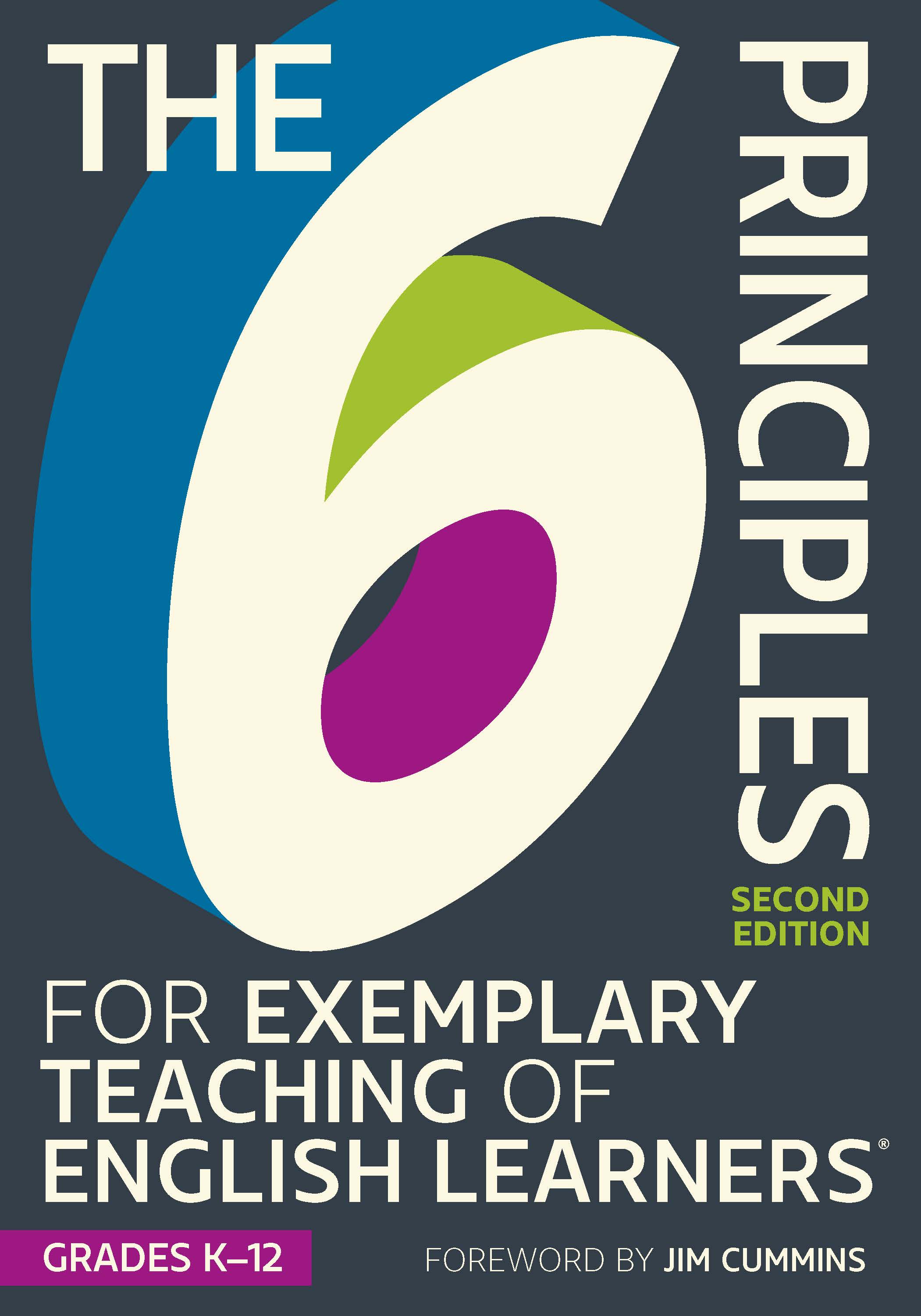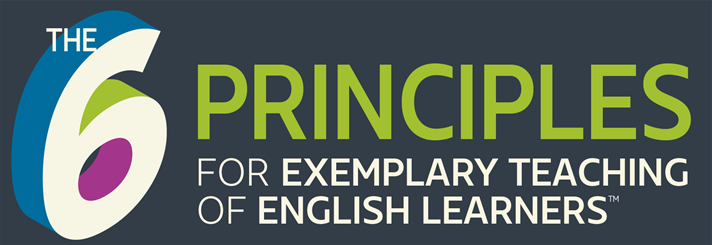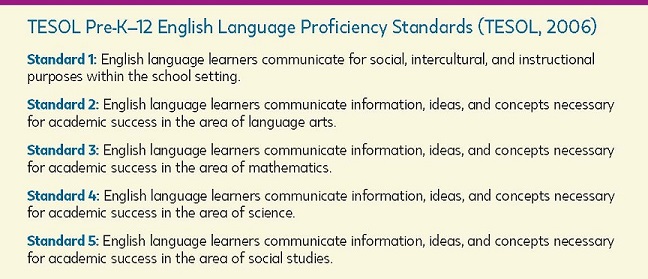
The 6 Principles for Exemplary Teaching of English Learners®: Grades K-12
Resource Page
This page complements the second edition of the book, The 6 Principles for Exemplary Teaching of English Learners: Grades K-12. Resources from the first edition can be found here.
Organized by book chapter, these additional materials and resources can help you learn more about the 6 Principles and how to implement them in your classroom, program, or school. For the purposes of a book study group or self-reflection, discussion questions for each chapter are provided.
The 6 Principles were developed by a team of language experts. Grounded in research and with contributions and support from educators around the world, the TESOL Board of Directors, and TESOL Staff, these principles are the result of years of exploration, inquiry, conversation, and collaboration.
The 6 Principles Writing Team:
- Deborah J. Short, Lead Writer
- Wing Shuen (Alice) Lau
- Helene Becker
- Nancy Cloud
- Andrea B. Hellman
- Linda New Levine
- Fatima Aldajani
For additional resources and information on The 6 Principles, please visit The Principles and Products pages.
Chapter 1. A Vision for Exemplary Teaching |
The 6 Principles Quick Overview:
Video: An Overview of the 6 Principles with Deborah Short
In TESOL’s Vision:
- Curricula for multilingual learners of English are rigorous, relevant, and designed and delivered with second language learning in mind.
- Multilingual learners of English, including learners with special needs, have access to all programs and services.
- All educational personnel assume responsibility for the education of multilingual learners of English.
- All educational personnel
- respect, affirm, and promote students’ home languages and cultural knowledge and experiences as resources;
- celebrate multilingualism and diversity;
- support policies that promote individual language rights and multicultural education; and
- help prepare students to be global citizens.
- TESOL professionals are recognized as specialists with accurate knowledge, skills, and dispositions for providing high-quality English language teaching.
- TESOL professionals are valued by colleagues and other educators for their expertise and consulted in instructional, programming, and policy decision-making.
TESOL International Association’s commitment to these characteristics of effective English language education programs are reflected in its DEIA (Diversity, Equity, Inclusion & Access) Initiative.
Chapter 2. What Teachers Should Know about English Language Development to Plan Instruction |
Video: What Teachers Should Know about Learning with Andrea Hellman
TESOL Pre-K-12 English Language Proficiency Standards:
Learn more about TESOL’s PreK-12 standards HERE.
Video: Three Critical Components for the Effective Education of Multilingual Learners of English
Video: Proficiency in a New Language
The Types of Words to Learn
- High frequency words
- Sight words
- General academic words (www.newgeneralservicelist.com/new-general-service-list-1) and (https://www.wgtn.ac.nz/lals/resources/academicwordlist)
- Content vocabulary commonly used in school texts
Video: Translanguaging
Chapter 3. The 6 Principles for Exemplary Teaching of English Learners |
Video: Principle 3 with Linda New Levine
The following links are resources that can help with implementing the 6 Principles in the classroom:
- Colorín Colorado
- English Learner Tool Kit
- Newcomer Toolkit
- Refugee Children in U.S. Schools Toolkit
- Home Language Survey Data Quality Self-Assessment
- The GO TO Strategies: Scaffolding Options for Teachers of English Language Learners, K-12
- The Most Essential Tech Tools & Resources for Teachers of Bilingual & Multilingual Learners
- How to Use Technology to Support ELLs in Your Classroom
- The 6 Principles Quick Guide: Remote Teaching K–12 English Learners
Below are sample activities that can help apply specific principles in your instruction.
Classroom Activities that Support Principle 1: Know Your Learners
Try these activities from books in the popular New Ways Series from TESOL Press:
Try these activities from the TESOL Resource Center (TRC):
Try some Colorín Colorado activities: Getting to Know Immigrant Students and Families
Classroom Activities that Support Principle 2: Create Conditions for Language Learning
Try these activities from the TESOL Resource Center (TRC):
Try this activity from New Ways in Teaching with Humor from TESOL Press: Scientific Conference Who's Coming
Try some Colorín Colorado activities: Create a Welcoming Classroom
Classroom Activities That Support Principle 3: Design High-Quality Lessons for Language Development
Try these activities from books in the New Ways Series from TESOL Press:
Try these activities from the TESOL Resource Center (TRC):
- Communicative Competence and Performance: Getting Young Learners to Use the Target Language
- The Eight Planets Orbiting the Sun
Classroom Activities That Support Principle 4: Adapt Lesson Delivery as Needed
Try the following activities from the New Ways Series and the TESOL Resource Center (TRC) if you notice your students need some targeted support with their writing skills:
Classroom Activities That Support Principle 5: Monitor and Assess Student Language Development
Try these activities from books in the popular New Ways Series from TESOL Press:
- Building Rubrics Democratically
- Tickets Out: Checking for Comprehension
- Using Screencasts To Give Feedback
- Encouraging Peer Feedback With Sticky Notes
- Using Color Coded E Rubrics
Try these activities from the TESOL Resource Center (TRC): Incorporating Content and Language in Assessment
Try the activity below from Assessing English Learners in U.S. Schools (Farnsworth & Malone, 2014): Picture Retelling
It offers a formative assessment rubric that elementary teachers can use to determine student ability to retell texts.
Try some Colorín Colorado activities: Using Informal Assessments for English Language Learners
Activities That Support Principle 6: Engage and Collaborate within a Community of Practice
Read the blog by Linda New Levine: Teachers as Learning Partners: Implementing Principle 6
Become more engaged in your profession:
- Participate in continuous learning and ongoing professional development
- Join a professional English teaching organization like TESOL International Association to learn and to participate in committees and groups
- Attend local and global conferences, like the annual TESOL International Convention & English Language Expo
- Participate in online discussions
- Develop leadership skills so you can be a resource at school and offer professional development workshops or act as a peer coach to a colleague
- Take some or all of the TESOL online modules focused on the 6 Principles
Video: Book Study with the 6 Principles
(Jannett DuHart, TESOL Advocacy & Policy Summit attendee)
Chapter 4. Additional Roles for Teachers of English Learners |
Video: Ways You Can Advocate for Your Students with Helene Becker
Chapter 4 discusses how teachers as advocates can provide a voice in five key areas: Academics, Social-emotional needs, Access to programs and opportunities, Support for families, Societal and legal issues. The following resources can help teachers incorporate the 6 Principles in their roles outside the classroom.
Academics, Access to Programs and Opportunities, and Societal and Legal Issues
- English Learner and Immigrant Rights in PK–12 Public Schools
- U.S. Department of Education Resources
- Seal of Biliteracy
- Special Education and ELLs: Recommended Resources
Support for Families
- Engaging ELL Families: 20 Strategies for School Leaders
- How to Support Immigrant Students and Families: Strategies for Schools and Early Childhood Programs
- Making Your First ELL Home Visit: A Guide for Classroom Teachers
Social-Emotional Needs
- Cognitive Behavioral Intervention for Trauma in Schools (CBITS)
- How to Support the Social and Emotional Health of Middle/High School ELLs
Additional Resources
- TESOL Zip Guide: Advocating for English Learners: This resource for English language educators working with kindergarten through adult language learners explains fundamentals needed to develop skills to advocate for multilingual learners, including identification of issues, strategies and guidance for classroom, school, and community advocacy, tips for keeping an asset framework in mind, and suggestions for how to bring advocacy-focused assignments into TESOL teacher preparation.
- Refugee Children in U.S. Schools: A Toolkit for Teachers and School Personnel
Bridging Refugee Youth & Children’s Services (BRYCS). (n.d.)
This resource shares information about serving refugee children and youth in U.S. schools. Tool #5 outlines federal requirements for providing interpretation and translation in schools. The document includes links to legislation and other helpful resources. - Colorín Colorado’s Facebook Live series on Advocacy for English Language Learners
Chapter 5. Establishing a Culture of Shared Responsibility |
Video: Shared Responsibility in Schools with Nancy Cloud
The following resources can support school staff in implementing the 6 Principles.
School Principals and Assistant Principals
How You Can Help to Fulfill Principle 1: Know Your Learners
- Making Your First ELL Home Visit: A Guide for Classroom Teachers
- ELL Family Outreach
- A Guide for Engaging ELL Families: Twenty Strategies for School Leaders
- How to Partner with Families of Middle and High School ELLs
- Empowering English Learners as Assets
- What School Leaders Need to Know About English Learners
How You Can Help Your School to Fulfill Principle 2: Create Conditions for Learning
- Seal of Biliteracy
- ELL Laws & Regulations
- English Learner and Immigrant Rights in PK–12 Public Schools
- U.S. Department of Education Resources
- Supporting Newcomer Students & Parent Civic Engagement in the School
Best Practices in Working with Translators and Interpreters
- Bridging Refugee Youth and Children’s’ Services, Interpretation/Translation in the Schools
- Minnesota Department of Education, Working with Interpreters and Translators (2009)
- American Speech-Language-Hearing Association, Collaborating with Interpreters
- Tips on building an effective staff language service program
District Curriculum Directors
How You Can Help Your District to Fulfill Principle 1: Know Your Learners
- How to Support ELL Students with Interrupted Formal Education (SIFEs)
- Supporting English Language Learners with Limited Prior Schooling
- Supporting Long-Term English Learners
How You Can Help Your District to Fulfill Principle 3: Design High Quality Lessons for Language Development
- Bridges Program
- Language Objectives: The Key to Effective Content Area Instruction for English Learners and a related video
- See video for a strategy to identify language objectives
- See video for a strategy to write language objectives
Special Education Directors and Gifted and Talented Program Directors
How You Can Help Your District to Fulfill Principle 1: Know Your Learners
- The Over- and Under-Identification of ELLs in Special Education
- 15 Tips for Improving Identification of Gifted EL Students
- Developing a Culturally and Linguistically Responsive Approach to Response to Instruction & Intervention (RtI²) for English Language Learners
How You Can Help Your District to Fulfill Principle 5: Monitor and Assess Student Language Development
Special Education and English Learners
- Addressing ELLs’ Language Learning and Special Education Needs: Questions and Considerations
- Tools and Resources For Addressing English Learners With Disabilities
- Supporting Multilingual Learners Through MTSS
- ELLs in Gifted/Talented Programs
Reading Specialists or Instructional Coaches How You Can Help Your District or School Fulfill
How You Can Help Your District or School Fulfill Principle 2: Create Conditions for Learning
- Identity Texts and Academic Achievement: Connecting the Dots in Multilingual School Contexts
- Lee & Low Books
- Del Sol Books
- The Coaching and Self-Reflection Tool for Competency in Teaching English Learners
How You Can Help Your District or School Fulfill Principle 3: Design High Quality Lessons for Language Development
- Literacy Instruction for ELLs
- The Home Language: An English Language Learner's Most Valuable Resource
- Empowering ELL Parents & Families at Home
- See all segments of the “Original Interview” by Pat Mora Videos on Colorin Colorado at meet Pat Mora, especially the segments “missing heritage”; “a vein of gold”, “partnering with Latino parents” and “reaching out to Latino families”. Also available here.
- Dynamic Duo: Teaching Reading and Writing Together
How You Can Help Your District or School Fulfill Principle 6: Engage and Collaborate Within a Community of Practice
- Literacy Instruction for Multilingual Learners: Books for teachers to use for professional study circles
Paraeducators
How You Can Help Your District to Fulfill the 6 Principles
Technology Coordinators
How You Can Help Your District to Fulfill the 6 Principles
- The 6 Principles Quick Guide: Remote Teaching K–12 English Learners
- The Most Essential Tech Tools & Resources for Teachers of Bilingual & Multilingual Learners
- Engaging Online Language Learners: A Practical Guide
Librarians and Media Specialists
How You Can Help Your District or School Fulfill the 6 Principles
- The Importance of Diversity in Library Programs and Material Collections for Children
- Librarians
- Family Literacy Nights
- School Libraries & ELLs
- Guide for Selecting and Using Culturally Appropriate Children’s Books in Languages Other Than English
Guidance Counselors, Social Workers, and School Psychologists School Principals and Assistant Principals
How You Can Help Your District or School Fulfill the 6 Principles
- Communicating Cross-Culturally: What Teachers Should Know
- How to Support the Social and Emotional Health of Middle/High School ELLs
- Australian Psychological Association, Working with Interpreters: A Practice Guide for Psychologists (2013)
- Partnering with Parents and Families to Support Immigrant and Refugee Children at School
Resources to Support Undocumented Families and DACA (Deferred Action for Childhood Arrivals) Youth
- Immigration Legal Resource Center
- American Civil Liberties Union
- United We Dream
- Harvard Graduate School of Education
- National Immigration Law Center
- Teaching Tolerance
- Informed Immigrant
Chapter 6. Implementing The 6 Principles in Different Contexts |
- Christian Quevedo’s lesson plan: The Storyteller’s Cauldron
- Theresa Johnson’s lesson template for teacher candidates in English Language Arts and TESOL
- Karamjeet Singh’s professional development lesson to introduce the 6 Principles
- Session Recording: The 6 Principles in Action
Presenters: Deborah Short; Helene Becker; Andrea Hellman; Nancy Cloud; Linda New Levine
Recorded at the TESOL 2018 International Convention & English Language Expo in Chicago, Illinois, USA.
Additional Content & Resources |
Teacher Leadership for School-Wide English Learning (SWEL)
The Teacher Leadership for School-Wide English Learning (SWEL) book and workshop series present a systematic framework for teacher professional learning and prepare language teachers to be site-based leaders in their schools, sharing their expertise with colleagues through collaborative discussions and observations.
TESOL ME (Modular Education): The 6 Principles Series


